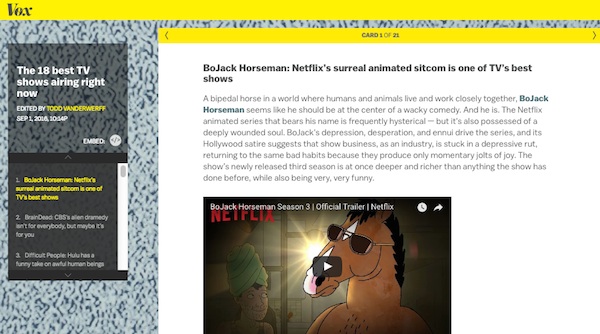
Two years after Vox.com launched its “card stacks,” the site’s editor in chief admits they’re not the game-changer he thought they’d be.
The site debuted during the explainer journalism trend of 2014, and the card stacks were meant to be its main differentiator. The editorial feature organizes information, index card-style, about all kinds of topics that were in the news, from Pope Francis to Bitcoin, in plain English and an easy-to-navigate format. The cards would not only help grow the Vox.com audience but provide a template for parent company Vox Media’s other verticals to use, as Curbed and Eater have done to showcase the best places to live and eat in a given city. They could be continuously added to and embedded on other sites.
Critics have praised the card stacks while also recommending they be more consistent in length and wondering if it’s possible to do the work of keeping them updated. Other sites, including AJ+ and Forbes, have also adopted the cards format.
“When I go back to the beginning, the amount of our mind space that were taken up by the card stacks, it’s like 75 percent. It was the instantiation of all of our ideas,” Vox.com co-founder and editor in chief Ezra Klein said on the August 9 edition of the podcast, The Ezra Klein Show.
Now, he acknowledges their limitations. The card stacks were the cornerstone of Vox.com’s product theory, that a single product could solve the problems of the online news system. “It was an idea of, we could create one big innovation, and that would change the way the whole thing worked,” Klein said on the podcast, where he was joined by Melissa Bell, one of the founders of Vox.com and driver of the card stacks. “I’m still proud of them and we still use them, but they’re not going to change the whole game. I think that’s clear.”

Bell, who’s now publisher of Vox Media, said in a separate exchange that she’s happy with the card stacks in a lot of ways. First and foremost, they provided lessons about making content for the distributed web. Teachers and students around the country used them as an educational resource. But she also conceded that they couldn’t solve all online media’s problems.
“The issue of a confused, overly complicated news system is much bigger, much broader than news websites. It’s very much a problem of television news, and its 24-hour channels,” she told Digiday. “It’s a problem of platforms, which you can see with Facebook rethinking their trending news module. It’s an issue with Twitter not being able to capitalize on their news influencer audience. It’s the problem, fundamentally, of the broken trust audiences have in the amorphous, unidentified ‘media’ in Pew surveys. That problem can’t be solved with a single product innovation. We have to stop trying to find a single problem. It needs to be solved in a million different ways, every single day.”
Bell said Vox.com needs to take the ideas behind the card stacks — adding expertise to subjects, repurposing editorial content, recognizing news stories have a larger context to them — and apply them to other things the site does, whether it’s a podcast, video or election coverage.
Vox Media isn’t alone as a media company in putting its faith in technology and product features as a way to grow their audiences and keep them coming back. What the past two years has also shown is how much more distributed the news has become.
Klein said during the podcast that he realized that the site wouldn’t hinge on one single big product but that Vox.com is differentiating itself in a lot of smaller ways, through things like graphics, video, podcasts and the writing itself.
Bell responded that the growth of off-platform audiences across the industry has helped Vox.com put its energy into thinking about how to build a strong distributed brand that meets people where they are.
“What we’re seeing across the industry is, the website audiences are there, but we’re seeing two or three or four times larger audiences off our websites. We did not totally get that when we were walking into Vox. … If we had, maybe we would have never even built a website to start.”
Bell later clarified that she was being “a bit hyperbolic” and that the company is very happy with Vox.com. “We like our website very much, and we like the audience it attracts even more,” she said. “I’m glad we built it.”
More in Media

Why some publishers aren’t ready to monetize generative AI chatbots with ads yet
Monetization of generative AI chatbot experiences is slow going. Some publishing execs said they’re not ready to add advertising to these products until they scale or can build a subscription model first.

Media Briefing: Publishers who bet on events and franchises this year are reaping the rewards
Tentpole events and franchises are helping publishers lock in advertising revenue.

With Firefly Image 3, Adobe aims to integrate more AI tools for various apps
New tools let people make images in seconds, create image backgrounds, replacing parts of an image and use reference images to create with AI.





